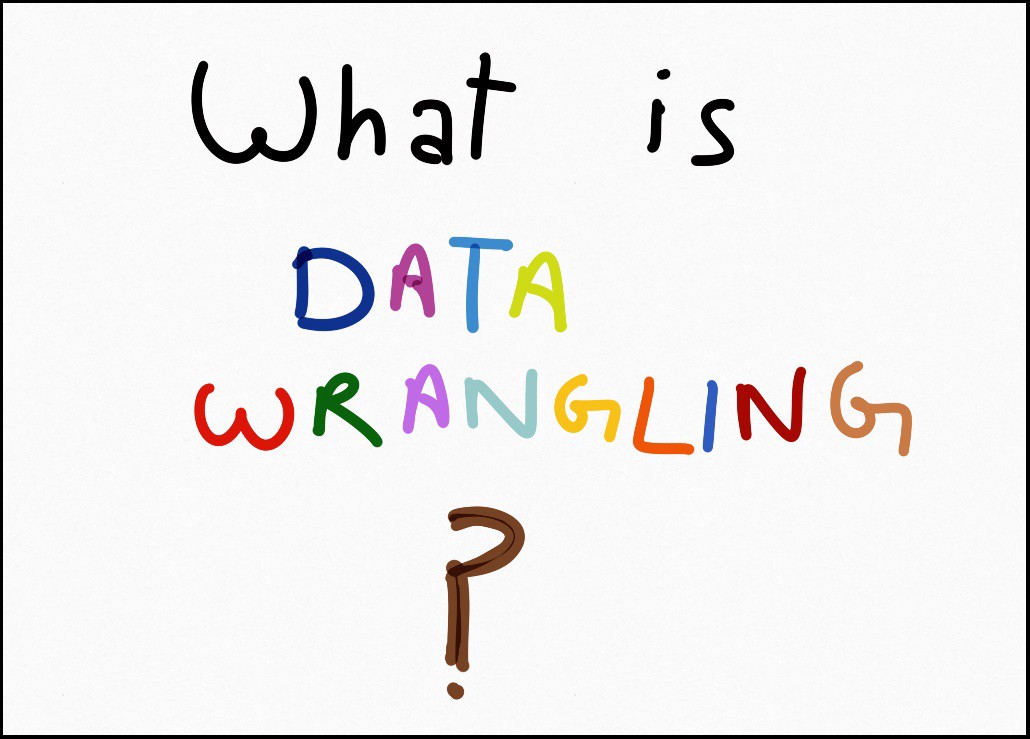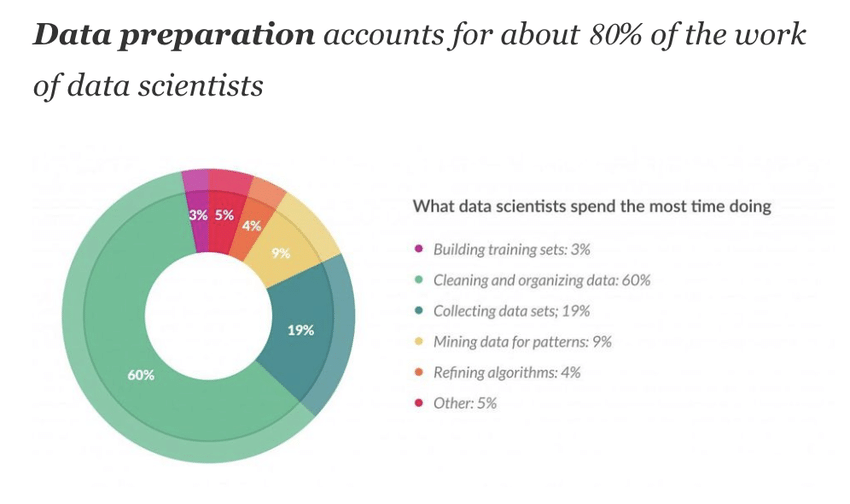Day 4: Data Wrangling and Cleaning
 Brian Wanjala
Brian Wanjala
What is Data Wrangling?
Data Wrangling is the process of cleaning, organizing, structuring, and enriching the raw data to make it more useful for analysis and visualization purposes. With more unstructured data, it is essential to perform Data Wrangling for making smarter and more accurate business decisions. Data Wrangling usually involves manually converting and mapping data from its raw state to another format that can be used for business purposes and is convenient for the consumption and organization of the data.
What are the Benefits of Data Wrangling?
Data professionals spend as much as 80% of their time in the data-wrangling process.

Only 20% is spent on exploration and Marketing, which begs the question “Is Data Wrangling worth the effort?“
Well, considering the many benefits Data Wrangling provides, it’s certainly worth putting in the time.
Here are some of the benefits Data Wrangling offers your business:
Easy Analysis: Once raw data is wrangled and transformed, Business Analysts and Stakeholders are empowered to analyze the most complex data quickly, easily, and efficiently.
Simple Data Handling: The Data Wrangling process transforms raw, unstructured, messy data into usable data arranged in neat rows and columns. The process also enriches the data to make it more meaningful and provide deeper intelligence.
Better Targeting: When you’re able to combine multiple sources of data, you can better understand your audience which leads to improved targeting for your Ad Campaigns and Content Strategy. Whether you’re trying to run Webinars to showcase what your company does for your desired customers, or use an online course platform to develop a training course for your own company, having the proper data to understand your audience is crucial to your success.Efficient Use of Time: The Data Wrangling process allows analysts to spend less time struggling to organize unruly data and more time on getting insights to help them make informed decisions based on data that is easy to read and digest.
Clear Visualization of Data: Once the data is wrangled, you can easily export it to any Analytics Visual Platform of your choice so you can begin to summarize, sort, and analyze the data.
All of this translates to better decision-making. But, this is far from the only benefit that comes from Wrangling Data.
Here are a few more amazing advantages:
Data Wrangling helps to improve Data Usability by converting data into a format that is compatible with the end system.
It aids in the quick and easy creation of data flows in an Intuitive User Interface where the data flow process can be easily scheduled and automated.
Data Wrangling also integrates Different Types of Information, as well as the sources, such as databases, files, web services, etc.
Data wrangling allows users to process Massive Volumes of Data and share data flow techniques easily.
Reduces Variable Expenses related to using external APIs or paying for software platforms that aren’t considered business-critical
What are the Steps to Perform Data Wrangling?
Below, we are going to take a look at the six-step process for data wrangling, which includes everything required to make raw data usable.
Here I will just list them out. We will handle them later as it is a pretty bigger topic and I am avoiding being a bore in the article.
Step 1: Data Discovery - This is an all-encompassing term for understanding or getting familiar with your data.
Step 2: Data Structuring - This is a process whereby relevant information is extracted from fresh data. For example, if you are dealing with code scrapped from a website, you might parse HTML code, pull out what you need, and discard the rest.
Step 3: Data Cleaning - Data Cleaning involves Tackling Outliers, Making Corrections, Deleting Bad Data completely, etc. This is done by applying algorithms to tidy up and sanitize the dataset.
Step 4: Data Enriching - Combining your raw data with additional data from other sources such as internal systems, third-party providers, etc. will help you accumulate even more data points to improve the accuracy of your analysis.
Step 5: Data Validating - Validating the data is an activity that services any issues in the quality of your data so they can be addressed with the appropriate transformations.
Step 6: Data Publishing - By this time, all the steps are completed and the data is ready for analytics. All that’s left is to publish the newly Wrangled Data in a place where it can be easily accessed and used by you and other stakeholders.
What are the Best Practices for Data Wrangling?
Data Wrangling can be performed in a variety of ways. But, several tools can help to facilitate the process. Depending on Who the data is presented for (an individual, organization, etc.), the specific Data-Wrangling approach can vary.
For instance, an online store owner might want to simply organize the data into a form that is easy for them to understand.
On the other hand, a professional in a large-scale consulting firm might require the Wrangled Data to be presented more comprehensively so they can glean deeper insights from it.
Regardless of your Data Wrangling objectives, some best practices apply in every case. I’ve listed some of them below:
Understand Your Audience
Pick the Right Data
Understand the Data
Reevaluate Your Work
Learn More About Data
1. Understand Your Audience
As previously stated, specific goals or needs for Data Wrangling can vary by organization. But, what’s important is knowing who will access and interpret that data, as well as what they hope to achieve, so you can include all the relevant information to help them get those insights.
For instance, if multiple stakeholders make it clear that the company will begin to use Webinar Software to drive more leads, it would make sense to make a view from within the data that gives them all demographic information about current customers so that the Marketing team understands who to target in their promotional material.
2. Pick the Right Data
As any analyst will tell you, it’s not about having lots of data, it’s about having the Right Kind of data.
That’s why Data Selection is so important. It will help you pick the data that is required right now for a specific purpose, as well as make it easier to find the data later should a similar need arise.
Here are some tips for picking the right data:
Avoid data with many nulls, same, or repeated values.
Steer clear of Derived or Calculated values and choose ones close to the source.
Extract data across a variety of platforms.
Filter the data to choose a subject that meets the conditions and rules.
3. Understand the Data
This is a very important part of assessing the quality and accuracy of your data. You must be able to see how the data fits within the governance rules and policies of your organization. When you understand the data you’ll be able to determine the right level of quality to suit the data’s purpose.
Here are some key points to remember:
Learn the data, database, and file formats.
Utilize visualization capabilities to explore the current state of the data.
Make use of profiling to generate Data Quality Metrics.
Be aware of the data’s limitations.
4. Re-evaluate Your Work
Although a business may have strict instructions for Data Wrangling, professionals may notice room for improvement upon completion of the process. Furthermore, the Wrangler may come across operations errors.
After completing the project, it’s a good idea to reevaluate the Wrangled Data to ensure that it is of the highest quality and organized as efficiently as possible. This will help to reduce inefficiencies and errors in the future.
5. Learn More About Data
For successful Data Wrangling to take place, analysts must have a firm grasp of the full scope of the resources and tools at their disposal. They must also have an in-depth understanding of the audience for whom they are wrangling the data.
Since the audience may grow, and the different tools and services may expand, data professionals need to adapt to these changes and stay up-to-date on breakthroughs and new technologies in analytics so they are always ready to provide effective data wrangling services.
What are the Use Cases of Data Wrangling?
Some of the common use cases of Data Wrangling are listed below:
Financial Insights
Data Wrangling is widely used by financial institutions to discover the insights hidden in data and uncover the numbers to predict trends and forecast the markets. It helps in answering the questions to make informed investment decisions.
Improved Reporting
Various departments in an organization need to generate reports of their activities or to get some specific information. But it becomes difficult to create reports with unstructured data. Data Wrangling improves the data quality and helps in fitting information in the reports.
Unified Format
Different departments of the company use different systems to capture the data which is in different formats. Data Wrangling helps in unifying the data and transforms data into a single format to get a holistic view.
Understanding Customer Base
Each customer has different personal data and behavior data. Using Data Wrangling, you can identify the patterns in the data and similarities between different customers.
Data Quality
Data Wrangling greatly helps in improving the quality of data. Data is an essential need of every industry to derive insights from it and make better data-driven business decisions.
Tools and Techniques for Data Wrangling
What tools do Data Wranglers use? There are tons of tools and techniques for Data Wrangling professionals to choose from, including Programming Languages, Software, and Open-Source Data Analytics platforms.
The tools you choose will depend on your needs for:
Processing and organizing data
Cleaning and consolidating
Extracting insights from data
Some tools facilitate data Processing while others help to make data more organized and easier to consume and interpret. Yet others offer all-in-one Data Wrangling solutions. You must choose the best tool that will help you, Wrangle Data, efficiently to benefit your organization.
Here’s a list of Data Wrangling tools that will help you uncover valuable insights from raw information:
Python and R
MS Excel
KNIME
Excel Spreadsheets
OpenRefine
Tabula
CSVKit
PythonPandas
Plotly
Dplyr
Purrr
Splitstackshape
JSOnline
You’ll also find some Visual Data Wrangling tools like OpenRefine and Trifecta that are designed for beginners. Such tools aim to make it easier for non-programmers to Wrangle Data. They can also help experienced data professionals by speeding up the process.
A word of caution about these tools: Although these visual tools are more intuitive and effective for helping you transform your data into well-structured formats, they are also less flexible. Since their functionality is more generic, they don’t always perform as well when dealing with complex datasets.
Conclusion
This is the end of this article on Data Wrangling. Use it as a guide to help you create useful data so end-users like Data Analysts, Engineers, Data Scientists, and other stakeholders can gain actionable insights from all the information you collect.
I can't wait to see you tomorrow on Day 5 as we go through Data Communication
Subscribe to my newsletter
Read articles from Brian Wanjala directly inside your inbox. Subscribe to the newsletter, and don't miss out.
Written by

Brian Wanjala
Brian Wanjala
My name is Wanjala. Currently the community lead of Nairobi AI (@Nairobi_ai) & a core team member of The Co-operative University of Kenya. I am a student pursuing a Bsc. in Business Information Technology. I have been able to pursue Data Science; part-time under the Co-operative University, Kenyatta University & the University of Nairobi sponsored Python for Data science course. I have been able to pursue Data Engineering classes as well under Lux tech Academy. I am also enrolled at ALX as a Software Engineer Trainee & currently in phase II and a member of The Room. I love fonts,speed and cars. I hate anything that wastes my time.